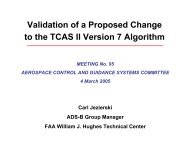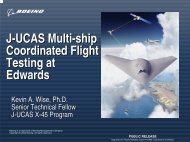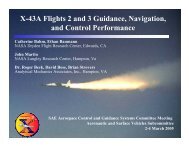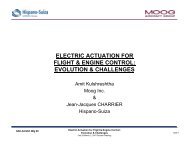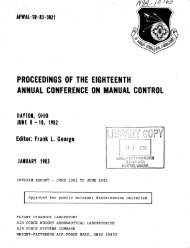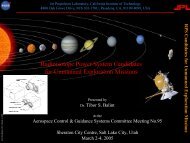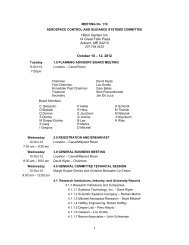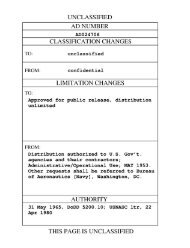Report of the Second Piloted Aircraft Flight Control System - Acgsc.org
Report of the Second Piloted Aircraft Flight Control System - Acgsc.org
Report of the Second Piloted Aircraft Flight Control System - Acgsc.org
Create successful ePaper yourself
Turn your PDF publications into a flip-book with our unique Google optimized e-Paper software.
IMPROVEMENT OF POWER SURFACE CONTROL SYSTEMS<br />
BY STRUCTURAL DEFLECTION COMPENSATION<br />
Power controls for operation <strong>of</strong> aircraft control surfaces have<br />
become a necessity as a result <strong>of</strong> increased airplane sise, speed,<br />
range and control requirements. The direct feedback linkage type<br />
<strong>of</strong> powered surface controls presents <strong>the</strong> problem <strong>of</strong> stability<br />
versus respome. Thie is especially true when a large surface<br />
inertia ie coupled vith a relatively law structural spring rate.<br />
Although <strong>the</strong>se systems nrny be eatisfactory for manual operation,<br />
<strong>the</strong>y msy prove marginal or u~atisfactory when used with automatic<br />
flight control equipment.<br />
A moans for improving <strong>the</strong> performance <strong>of</strong> a mechanical-Wdraulic<br />
control syrtm hoving high surface inertia aad low structural<br />
spring rate8 has been dweloped and has proven quite ~uccessful<br />
on an airplane installation. In this discuseion we will first<br />
cover a basic type powered surface control system; Them it will<br />
be shm how a rtructural deflection feedback linkage can be added<br />
to <strong>the</strong> cystom to imprwe performance.<br />
A BASIC TTPE PCMER OPERATED CONTROL mTEn<br />
A powered surface control system operating a high inertia surface<br />
which had a low reaction spring rate me~y be limited in performance.<br />
To retain stability <strong>of</strong> <strong>the</strong> system <strong>the</strong> gain must be kept low, resulting<br />
in slow response which my make <strong>the</strong> system Inadequate for<br />
8atisfactoi.g airplane control. This problem was encountered in<br />
<strong>the</strong> dwelopment <strong>of</strong> a rudder control system which is described belaw<br />
and shm In figure 1. operation <strong>of</strong> <strong>the</strong> pilot~s pedals rotatee<br />
<strong>the</strong> torque tube Xi by means <strong>of</strong> cables. A differential linkage ie<br />
l0~8ted at <strong>the</strong> upper en3 <strong>of</strong> <strong>the</strong> torque tube. Since <strong>the</strong> surface ie<br />
initially stationary, <strong>the</strong> movement <strong>of</strong> <strong>the</strong> torque tube causes movement<br />
<strong>of</strong> <strong>the</strong> error link X, which is connected to <strong>the</strong> Wraulic control<br />
valve. Displacement <strong>of</strong> <strong>the</strong> control valve admits pressure to one<br />
side <strong>of</strong> <strong>the</strong> piston ecld opens <strong>the</strong> o<strong>the</strong>r side to return. The resulting<br />
pressure differential supplies <strong>the</strong> force to mom <strong>the</strong> ndder<br />
against inertia, friction, damping and air load. The follou-up or<br />
feedbncK link connected to <strong>the</strong> rudder and to <strong>the</strong> differential<br />
<strong>the</strong>n moves <strong>the</strong> 3 ifferential to reduce <strong>the</strong> error to a minimum and<br />
closes <strong>the</strong> tgdraulic control valve. When <strong>the</strong> CIVW is a dniru, tb.<br />
valve ie in neutral and <strong>the</strong> fluid trapped on both side8 <strong>of</strong> <strong>the</strong><br />
pieton holds <strong>the</strong> rudder in one position against variable loads.<br />
This eystem as first installed in <strong>the</strong> airplane, fignre 2, prwed<br />
to be unstable. Any disturbance to <strong>the</strong> control surface or to <strong>the</strong><br />
pilot input resulted in a continuous oscillation <strong>of</strong> <strong>the</strong> eystem.<br />
To overcome this instability <strong>the</strong> system was slowed d m by reducing<br />
control valve gain. The net result wae a deterioration in<br />
performance and excessive phase lag. The combined lag <strong>of</strong> <strong>the</strong>



